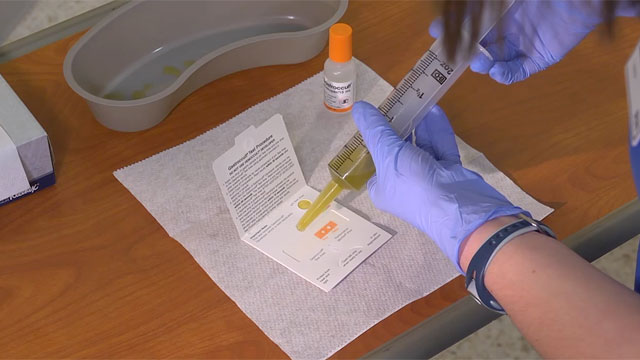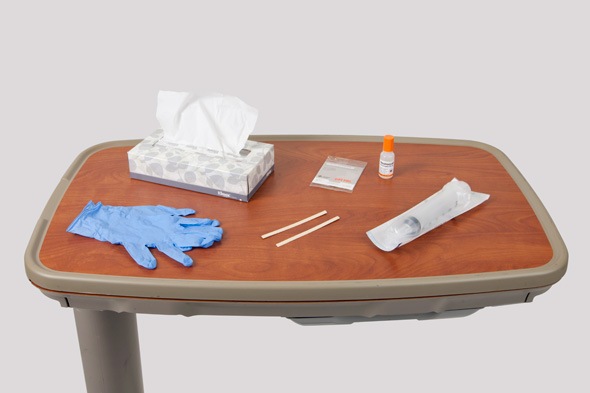Specimen Collection
Select a Skill:
- » Collecting a Midstream Urine Specimen
- » Performing Fecal Occult Blood Testing
- » Performing Gastric Occult Blood Testing
- » Collecting a Sputum Specimen
- » Collecting a Specimen for Wound Culture
- » Performing Blood Glucose Testing
- » Screening Urine for Chemical Properties
Take the Review Test:

Safety
- Discuss the test with the patient to verify the type of procedure scheduled and the procedure site.
- Follow standard precautions when collecting a specimen of blood or body fluid, and take any additional precautions for collecting specimens from patients who are in protective isolation.
- Ensure that specified prerequisite instructions, such as fasting and nothing by mouth (NPO), have been followed or required conditions met before the specimen is collected.
- Observe the specimen, and report immediately to the health care provider if it is tinged with red blood or contains coffee-ground material.
- If the test for occult blood is positive, continue to monitor the patient, and notify the health care provider.
Equipment
(Roll cursor over items to see labels)

Facial tissues
Wooden applicator or 3 mL syringe
60 mL bulb or catheter-tip syringe
Cardboard Gastroccult test slide
Gastroccult developing solution
Clean gloves
Delegation
The skill of performing gastric occult blood testing on stomach contents in an emesis basin can be delegated to NAP. You cannot delegate the skill if the specimen is to be collected from a nasogastric (NG) tube. Be sure to inform NAP of the following:
- Advise NAP to report immediately if blood or coffee-ground material is visible in the secretions.
- Instruct NAP to save positive specimens for repeat testing.
Preparation
- Assess the patient’s medical history of gastrointestinal (GI) disorders, such as a history of bleeding or colitis.
- Review the patient’s medication record for drugs that contribute to GI disorders.
- Explain the procedure to the patient and/or family members. Discuss why the specimen collection is necessary.
- Assess the patient’s or the family members’ understanding of the need for the test.
Follow-up
- Ask the patient to explain the reason for the procedure.
- Note the color changes on the guaiac paper.
- Note the character of the gastric secretions.
- If the test for occult blood is positive:
- Continue to monitor the patient.
- Notify the health care provider.
Documentation
- Record the results of the test and the presence of any unusual characteristics of gastric contents.
- Report positive test results to the health care provider.
Review Questions
1. What is the initial step in preparing to perform a gastric occult blood test for a patient with recurrent vomiting?
 Determine the patient’s ability to help obtain the specimen.
Determine the patient’s ability to help obtain the specimen.  Gather a Gastroccult slide and developing solution.
Gather a Gastroccult slide and developing solution. Review the medications the patient is currently taking.
Review the medications the patient is currently taking. Perform hand hygiene, and apply treatment gloves.
Perform hand hygiene, and apply treatment gloves.
2. Why might the nurse delegate to nursing assistive personnel (NAP) the skill of performing a gastric occult blood test for a patient who has vomited?
 The task is easy to demonstrate to NAP.
The task is easy to demonstrate to NAP. The likelihood of a positive result is minimal.
The likelihood of a positive result is minimal.  This skill may be delegated if performed on vomited stomach contents.
This skill may be delegated if performed on vomited stomach contents.  The agency trains NAP to perform only NG tube testing.
The agency trains NAP to perform only NG tube testing.
3. Which statement best illustrates the nurse’s understanding of the role of nursing assistive personnel (NAP) in carrying out a gastric occult blood test for a patient with a low hemoglobin and hematocrit?
 “Have you used the new Gastroccult testing system?”
“Have you used the new Gastroccult testing system?”  “The next time the patient vomits, please test it for occult blood.”
“The next time the patient vomits, please test it for occult blood.”  “Is the patient capable of assisting with the specimen collection?”
“Is the patient capable of assisting with the specimen collection?”  “Remember to tell me the results of the test immediately.”
“Remember to tell me the results of the test immediately.”
4. Which statement best illustrates correct interpretation of a positive gastric occult blood test?
 “We don’t need to retest the patient right now, because the sample turned green after about 60 seconds.”
“We don’t need to retest the patient right now, because the sample turned green after about 60 seconds.”  “If the test sample turns blue, it is positive for blood.”
“If the test sample turns blue, it is positive for blood.”  “The monitor area needs to turn blue within 30 seconds.”
“The monitor area needs to turn blue within 30 seconds.”  “Because it was positive, I notified the patient’s physician.”
“Because it was positive, I notified the patient’s physician.”
5. Which nursing action addresses the risk for infection related to gastric occult blood testing?
 Maintaining aseptic technique while handling the Gastroccult slide
Maintaining aseptic technique while handling the Gastroccult slide  Performing the test in the patient’s bathroom
Performing the test in the patient’s bathroom  Assessing the patient’s history of previous gastrointestinal (GI) bleeding
Assessing the patient’s history of previous gastrointestinal (GI) bleeding  Ensuring appropriate hand hygiene before and after testing
Ensuring appropriate hand hygiene before and after testing
You have completed the Review Questions for this skill. To take the Review again select the Start Over button. To proceed to another skill select from the dropdown menu. Select the Home or Back button to proceed to the next section.


